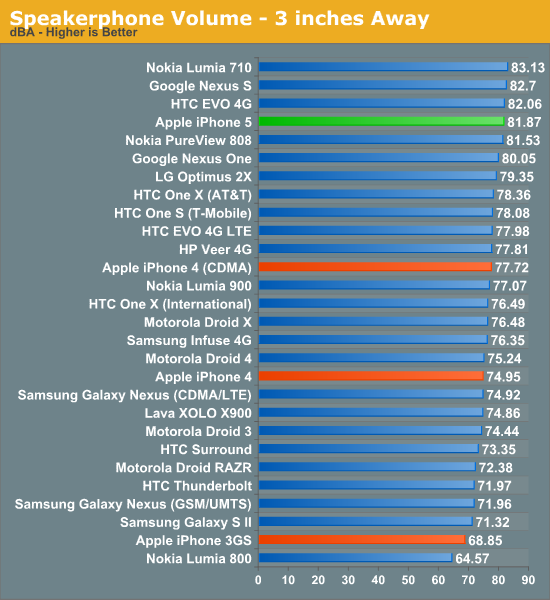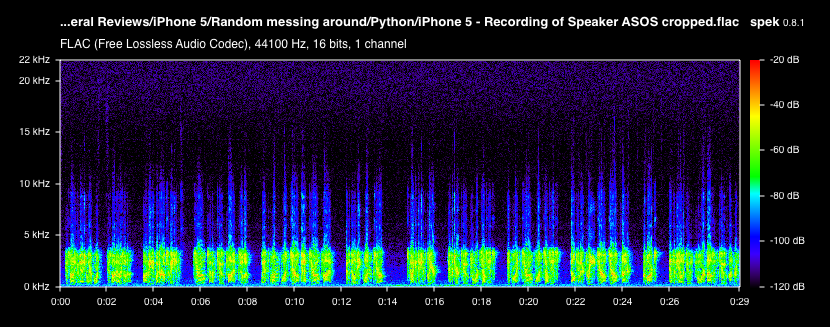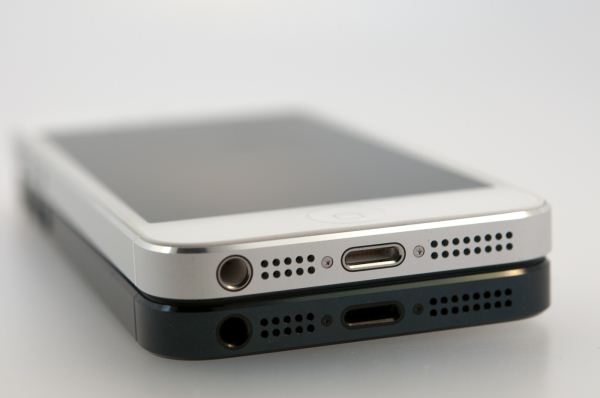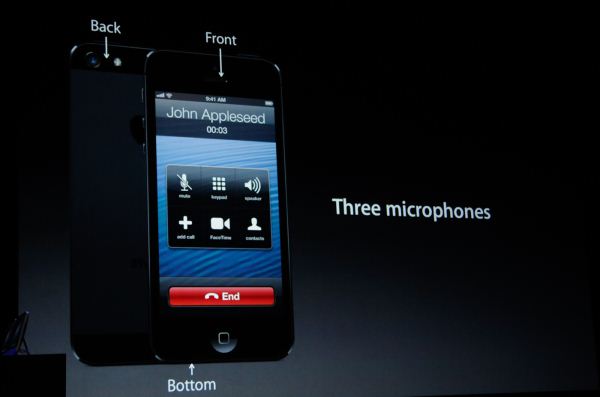The iPhone 5 Review
by Anand Lal Shimpi, Brian Klug & Vivek Gowri on October 16, 2012 11:33 AM EST- Posted in
- Smartphones
- Apple
- Mobile
- iPhone 5
Speakerphone and Noise Suppression
Section by Brian Klug
When Apple changed up the dock connector with the smaller Lightning port, it afforded a chance to also redesign the speakerphone at the bottom of the iPhone 5. Between the iPhone 4 and 4S we saw minimal changes, and performance was acceptable if a bit on the quiet side. With the iPhone 5 Apple advertised a big gain in audio quality with both changes to the speaker and a 5 magnet transducer design.
We normally test speakerphones by calling the local ASOS test number at max volume in front of an Extech sound data logger sampling continually and then averaging over one readout of the weather report. This gives a good feel for the overall loudness of the speakerphone on a call, but doesn’t tell us anything about quality unless you’re standing in front of it. In this case, the iPhone 5 is quite loud and comes in near the top of our scale at 81.8 dBA. It isn’t chart topping but a definite improvement over the relatively quiet 4/4S speakerphone design.

I decided to do something different though after getting a lot of questions and emails asking for a better quality comparison between the iPhone 5 speaker and its predecessor. People are interested in using their smartphones to listen to music when speakers or a dock aren’t available, and I thought this worth investigating. To get to the bottom of this I used my Blue Yeti USB microphone and arm which I use for podcasting to record the speakerphone output at 90 percent volume on the iPhone 4S and iPhone 5.
I started with the test call, which sounds surprisingly different between the iPhone 4S and iPhone 5. The 4S saturates and has obvious distortion even at 90 percent volume. This is quite noticeable in the recording. It then occurred to me that because I’m calling over AT&T (narrowband AMR) and to a PSTN (public switched telephone network) that the call would be limited to 4 kHz thanks to filters along the route, therefore anything above 4 kHz is undesirable. I took a spectral analysis (which shows power spectral density), and instantly it became obvious just how much energy there is on the 4S above the 4kHz limit from overmodulation or saturation/clipping on that speakerphone design. Meanwhile the iPhone 5 has much less energy over that 4 kHz maximum for a PSTN call.
I did the same for two songs recorded start to finish, and the differences are quite noticeable even in my rather quick and dirty recording plus spectogram comparison. I cropped the two recordings of the songs quite a bit and stuck them on soundcloud.

My overall impressions with the iPhone 5 speakerphone is that it has much less of a tendency to clip and saturate than the 4S, all while being noticeably louder. It’s still a smartphone speakerphone but to my ears the difference is pretty dramatic.
Noise Suppression
We’ve known for a while now that Apple changed up the slot for noise cancellation in the iPhone 5. The story goes something like this — Audience was a discrete chip on the iPhone 4, an IP block on the A5 SoC for iPhone 4S, and also an IP block onboard the A6 SoC for iPhone 5. The difference is that with iPhone 5 Audience isn’t enabled, and the company knows this because final characterization with both the final industrial design, microphones, and performance was never performed. Audience claims it met all of its deliverables and targets with the new IP block it built and gave Apple for inclusion on the A6. There’s obviously a lot of speculation about exactly why Apple chose to go with its own soultion versus Audience.
We’ve seen Audience earSmart noise suppression processors in a number of smartphones to date, and carriers often have their own specification for noise suppression to get certified. In addition, with wideband voice (AMR-WB in the case of the iPhone 5) noise suppression is even more important, to say nothing of how big of a topic this is with voice recognition based features like Siri. While we’re on the subject of AMR-WB, this feature is enabled on the iPhone 5 but I’m unable to test it on any of the carriers in the USA at the moment.
Anyhow, the iPhone 5 uses an Apple-specific solution with three total microphones all around the device. One primary microphone at the bottom of the device where you’d expect the primary microphone to reside, a secondary microphone between the LED flash and camera module, and a third right next to the earpiece for use with earpiece active noise cancelation. Apple’s solution is a beamformer (Apple said so in the keynote) and from what I can tell thus works entirely in the time domain. I’ve spent a lot of time playing around with the iPhone 5 trying to characterize its noise rejection, and the system appears to have a number of modes it will kick into after a 5–10 second adaptation time.
Earpiece noise rejection is something I talked about on the podcast right after the iPhone 5 hands on, and is one of those modes that the iPhone 5 will kick into if you’re in a loud environment. It isn’t active all the time, but when it does transition into working it provides a noticeable suppression of ambient noise and the same kind of pressure I’ve felt with other active noise canceling closed ear headphones. The improvement isn’t overwhelming, but it’s a sensation and feature I haven’t experienced on any other smartphones to date.
The rest of the noise suppression story is really one of testing. To test, I ran our normal test suite which consists of me ramping ambient music to 94 dBA while speaking into the device under test and recording the other side of the call. I’ve gotten ahold of the industry standard babble and distractor tracks used by carriers for testing noise suppression and will move to those in the future, for now though the test track I currently play is something I understand pretty well.
The comparison here is between the iPhone 4S and iPhone 5 to see just how ambient noise suppression has changed with this change in solution. The difference in technique is pretty apparent, and again indicates to me that the iPhone 5 is working in the time domain. You can see visible cut in and cut out on the waveform. The Audience solution has some hiss that develops at the absolute highest background noise volume on the 4S, but it also does an excellent job suppressing noise. The Apple solution doesn’t have this hiss, but passes both background noise and vocals from the music passed through the call at maximum volume. I hate to call this a regression, but the difference in technique means that there’s audible background noise that gets passed on while I’m talking on the iPhone 5. I think for normal callers the difference won’t be readily apparent, but with close inspection it is dramatic.













276 Comments
View All Comments
grkhetan - Wednesday, October 17, 2012 - link
Multiple display reviews conclude that the iPhone 5 has the best display in a smartphone (And much better than a Samsung Galaxy S 3)http://www.displaymate.com/Smartphone_ShootOut_2.h...
http://www.anandtech.com/show/6334/iphone-5-screen...
rarson - Thursday, October 18, 2012 - link
Your second link doesn't compare it to anything but the iPhone 4. Your first link ONLY compares it to the S3. Neither link supports your statement ("best display in a smartphone").doobydoo - Friday, October 19, 2012 - link
A quote from his second link:'To put this in perspective, in the past few years I've reviewed probably 30-40 different displays, from PC monitors to TVs to projectors. Not a single one, out of the box, can put up the Gretag Macbeth dE numbers that the iPhone can, and perhaps one projector (which listed for $20,000) can approach the grayscale and color accuracy out of the box.'
steven75 - Wednesday, October 17, 2012 - link
Those pesky facts are annoying!Obsoleet - Tuesday, October 16, 2012 - link
No, it's not. There's many reasons the GS3 is the better choice based on the software and hardware, mainly that the MaxxHD only matches a 5 month old phone in hardware specs and tosses on a bigger battery as the only clear win (but you get stuck with a Motorola phone vs most people's preferred choice Samsung).But the killer reason is that the charger is on the left hand side.
For many of us lefties, that is a deal breaker. As a right handed user, you don't realize this. I want the ports on the top or bottom, and I just ordered a GS3 because of this being a tipping point.
The original Maxx had the ports on the top! Motorola is clueless.
Never again.
Ckaka1993 - Thursday, December 6, 2012 - link
Ppi does make a difference. Go see the videos of droid dna(has 440) ppi and you can make out the difference. iPhone 5 doesnt have true 720p but that doesn't matter cause it's quite close to 720p. Anyways iphone5 is behind so many smartphones at present. Nokia lumia 920 is a treat to watch with its 332 ppi pure motion hd+ display and high refresh rate, u can make out the difference. But nexus 4 is the smartphone which gives u the best worth for money at ony 350usd it is freaking awesomemakken - Tuesday, October 16, 2012 - link
The Physical Comparison table lists the iPhone 5's resolution at 1136 x 960, instead of 1136 x 640. Threw me off for a second there =PBrian Klug - Tuesday, October 16, 2012 - link
Oops, fixing. There's always something in the table that needs fixing it seems :P-Brian
DukeN - Tuesday, October 16, 2012 - link
And always favorably on the Apple side.Maybe you took a picture of the pixel count with the iPhone's camera...
Alucard291 - Tuesday, October 16, 2012 - link
I know I love how their own benchmarks show how the battery life is worse in just about everything than the 4s and yet and yet "its better" >.>